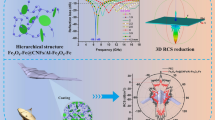Abstract
A method of formation of three-dimensional arrays of magnetically controlled particles from iron oxide Fe3O4 using a rotating permanent magnetic field is developed to create a material that absorbs electromagnetic radiation in the microwave range. The use of laboratory setup with a rotating magnetic field of permanent magnets makes it possible to obtain a composite with a close packing of particles, in which the principle of self-organization of monolayers of magnetic particles is realized. The reflection spectra, absorption spectra, and attenuation spectra of the electromagnetic radiation of composites with a three-dimensional array of close-packed magnetic particles of Fe3O4 with a thickness of 3 mm and 6 mm consisting of 15 and 30 flat monolayers of particles, respectively, are obtained. The technique for three-dimensional arrays of magnetic particles of Fe3O4 and the laboratory setup for its implementation are promising to produce composite materials using a wide range of microparticles and nanoparticles.









Similar content being viewed by others
REFERENCES
Lv, H., Liang, X., Ji, G., Zhang, H., and Du, Y., Porous three-dimensional flower-like Co/CoO and its excellent electromagnetic absorption properties, ACS Appl. Mater. Interfaces, 2015, vol. 18, pp. 9776–9783.
Li, F., Wu, J., Qin, Q., Li, Z., and Huang, X., Controllable synthesis, optical and photocatalytic properties of CuS nanomaterials with hierarchical structures, Powder Technol., 2010, vol. 2, pp. 267–274.
Golovanov, O.A., Makeeva, G.S., Shirshikov, D.N., and Gorlov, G.G., Electrodinamic calculation of microwave transmission coefficients of mode h10 through a slab of nanostructured material based on the 3D-array of ferromagnetic nanowires, Izv. Vyssh. Uchebn. Zaved., Povolzh. Reg., 2013, no. 4, pp. 162–173.
Li, Y., Pan, K., Wang, G., Fan, N., and Miao, X., Synthesis and photoluminescence properties of perovskite KMgF3, J. Mater. Res., 2011, vol. 22, pp. 2867–2870.
Serebryannikov, S.V., Rumyantsev, P.A., Cherkasov, A.P., and Eremtsova, L.L., Magnetodielectric microwave radiation absorbers based on ferromagnetic compounds, Electrichestvo, 2013, no. 11, pp. 36–40.
Zhang, X.F., Dong, X.L., Huang, H., Lv, B., Lei, J.P., and Choi, C.J., Microstructure and microwave absorption properties of carbon-coated iron nanocapsules, J. Phys. D: Appl. Phys., 2017, vol. 7, pp. 5383–5388.
Shorstkii, I.A. and Savenkov, K.Yu., Self-cleaning filter based on magnetically controlled particles, Nauchn. Zh. Nats. Issled. Univ. Inf. Tekhnol., Mekh. Opt., Ser.: Protsessy Apparaty Pishch. Proizvod., 2017, no. 4, pp. 20–27.
Shorstkii, I.A., RF Patent 2544695, 2013.
Jian, X., Wu, B., Wei, Y., Dou, S.X., Wang, X., He, W., and Mahmood, N., Facile synthesis of Fe3O4/GCs composites and their enhanced microwave absorption properties, ACS Appl. Mater. Interfaces, 2016, vol. 9, pp. 6101–6109.
Parisi, G. and Zamponi, F., Mean-field theory of hard sphere glasses and jamming, Rev. Modern Phys., 2010, vol. 82, no. 1, pp. 789–845.
Kanaun, S.K., The self-consistent field method in the problem of the effective properties of an elastic composite, Prikl. Mekh. Tekh. Fiz., 1975, no. 4, pp. 194–200.
Du, Y., Liu, W., Qiang, R., Wang, Y., Han, X., Ma, J., and Xu, P., Shell thickness-dependent microwave absorption of core–shell Fe3O4C composites, ACS Appl. Mater. Interfaces, 2014, vol. 15, pp. 12997–13006.
Hou, Y., Yuan, H., Chen, H., Shen, J., and Li, L., Controlled fabrication and microwave absorbing mechanism of hollow Fe3O4C microspheres, Sci. China Chem., 2017, vol. 6, pp. 740–747.
Shorstkii, I. and Yakovlev, N., Synthesis of magnetically controlled Fe3O4 composites and their enhanced microwave absorption properties, Mater. Res. Express, 2019, vol. 6, art. ID 046104.
Funding
This work was supported by the Russian Foundation for Basic Research, project no. 18-38-00448.
Author information
Authors and Affiliations
Corresponding authors
Additional information
Translated by I. Obrezanova
Rights and permissions
About this article
Cite this article
Shorstkii, I.A., Yakovlev, N. Method of Absorbing Material Formation Based on Magnetically Controlled Particles of Fe3O4 . Inorg. Mater. Appl. Res. 11, 1236–1243 (2020). https://doi.org/10.1134/S2075113320050317
Received:
Revised:
Accepted:
Published:
Issue Date:
DOI: https://doi.org/10.1134/S2075113320050317




